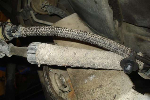Gday, I found this somewhere else. Don't know if it will help.
Those tires are rated for 2469 pounds each, so they can carry FAR more than a full-loaded T*******r at maximum gross vehicle weight. Although they are a "P" rated tire, in any other size, they would be more akin to an "LT" rated tire.
What this means is that "P" rated tires usually develop their maximum traction at somewhere around 80 - 90% of the max psi as listed on the tire sidewall.
"LT" tires, on the other hand, have much stiffer sidewalls - which is why they can carry a much greater load - and get the best traction in normal (not fully loaded) driving at 70 - 80% of the max psi listed on the sidewall.
I would therefore suggest that for maximum traction, maximum tread life and maximum comfort, you start with 40 psi all around and adjust from there. You can even go down to 35 psi all around and still stay safe.
Make sure you check the pressure with an accurate gauge and check them when COLD. (The max pressure listed on the sidewall is a cold rating, and when hot, they can easily climb to 10 psi or more higher than this.)
I would not go below 35 psi with these tires, and keep in mind that if you add a heavy load or carry more than two passengers, your tires can carry this load safely if you air them up a bit. It is highly unlikely you would ever need to air them up to 50 psi because if you are carrying 10,000 pounds of gross weight, you are probably on your own here!

(A good rule of thumb is to divide your vehicle gross weight by three instead of by four to get the approximate weight range of your tires. This is because if you blow a tire on the highway, the other three must then carry the load until you get stopped and get it changed.)
It is actually a bit of a fallacy that one doesn't pay any attention to the door sticker pressures if they have swapped out the OEM tires. The door stickers are still valuable because they will tell you minimum pressures to be safe and comfortable for the average driver, almost regardless of the tires put on the truck. (There will be few, if any, tires sold today in our sizes that would not be safe at sticker pressures.) However, most of us in here are not "average" drivers, and we may seek out the optimum pressures for maximum traction at both ends, and we can play with pressures a bit to get us the best compromise pressures for our own individual needs.
For example, I rarely carry back seat passengers so I run slightly more air in the front than the rear. This keeps the fronts from tucking under in tight corners and makes for a comfortable ride. My max psi rating on the sidewall is 41 psi so I run 36 front and 32 rear.










